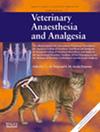超声引导下的狗阴茎阻滞:尸体研究和病例报告。
IF 1.4
2区 农林科学
Q2 VETERINARY SCIENCES
引用次数: 0
摘要
本病例报告介绍了超声引导下狗阴部神经阻滞的方法和使用。该技术首先在一只 14 千克重的阉割澳洲牧羊犬尸体上进行。超声探头横向放置在肛门和肛弓之间的中线上。通过平面内技术在双侧阴部神经周围注射亚甲蓝(0.05 mL kg-1),并确定以下地标:尿道、会阴动脉、内闭孔肌、球海绵体肌和牵引阴茎肌。注射后的解剖显示,肛门直肠峡部有弥漫性染色,每根约 25 毫米长的阴茎神经也有染色。一只 1 岁大的阉割雄性拉布拉多犬因远端尿道坏死脱垂而前来进行尿道切除和吻合术。手术前在超声引导下用 0.5% 布比卡因(每个部位 0.05 mL kg-1)进行了阴部神经阻滞。用美沙酮[0.3 mg kg-1 静脉注射(IV)]和右美托咪定(2 μg kg-1 IV)对该犬进行预麻醉,然后用氯胺酮(1 mg kg-1 IV)和丙泊酚(根据效果滴定;总计 1.4 mg kg-1 IV)进行全身麻醉。气管插管,异氟醚与氧气混合维持麻醉。拔管时给狗注射卡洛芬(2.2 毫克/千克-1 皮下注射)。在手术后的 18 小时内直到出院,该犬都不需要术中或术后镇痛抢救干预。这项技术似乎成功地对远端尿道进行了脱敏处理。有必要对这种局部技术进行进一步研究。本文章由计算机程序翻译,如有差异,请以英文原文为准。
Ultrasound-guided pudendal block in the dog: a cadaver study and case report
This case report describes the approach and use of an ultrasound-guided pudendal nerve block in dogs. The technique was first performed in the cadaver of a 14 kg male castrated Miniature Australian Shepherd dog. The ultrasound probe was placed in transverse orientation on midline between the anus and ischiatic arch. Methylene blue (0.05 mL kg−1) was injected around the pudendal nerves bilaterally via an in-plane technique, with the following landmarks identified: urethra, perineal arteries, and internal obturator, bulbospongiosus and retractor penis muscles. Postinjection dissection revealed diffuse staining of the ischiorectal fossae and staining of an approximately 25 mm length of each pudendal nerve. A 1-year-old castrated male Labradoodle dog presented for urethral resection and anastomosis due to necrotic prolapse of the distal urethra. An ultrasound-guided pudendal nerve block was performed with 0.5% bupivacaine (0.05 mL kg−1 per site) before surgery. The dog was premedicated with methadone [0.3 mg kg−1 intravenously (IV)] and dexmedetomidine (2 μg kg−1 IV), and general anesthesia was induced with ketamine (1 mg kg−1 IV) followed by propofol (titrated to effect; total 1.4 mg kg−1 IV). The trachea was intubated and anesthesia maintained with isoflurane carried in oxygen. The dog was given carprofen (2.2 mg kg−1 subcutaneously) on extubation. The dog did not require intra- or postoperative rescue analgesic interventions in the 18 hours after surgery until hospital discharge. This technique appeared successful in desensitizing the distal urethra. Further investigation of this locoregional technique is warranted.
求助全文
通过发布文献求助,成功后即可免费获取论文全文。
去求助
来源期刊

Veterinary anaesthesia and analgesia
农林科学-兽医学
CiteScore
3.10
自引率
17.60%
发文量
91
审稿时长
97 days
期刊介绍:
Veterinary Anaesthesia and Analgesia is the official journal of the Association of Veterinary Anaesthetists, the American College of Veterinary Anesthesia and Analgesia and the European College of Veterinary Anaesthesia and Analgesia. Its purpose is the publication of original, peer reviewed articles covering all branches of anaesthesia and the relief of pain in animals. Articles concerned with the following subjects related to anaesthesia and analgesia are also welcome:
the basic sciences;
pathophysiology of disease as it relates to anaesthetic management
equipment
intensive care
chemical restraint of animals including laboratory animals, wildlife and exotic animals
welfare issues associated with pain and distress
education in veterinary anaesthesia and analgesia.
Review articles, special articles, and historical notes will also be published, along with editorials, case reports in the form of letters to the editor, and book reviews. There is also an active correspondence section.
 求助内容:
求助内容: 应助结果提醒方式:
应助结果提醒方式:


